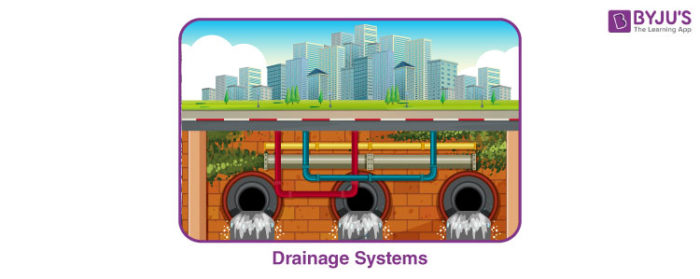A drainage system is an arrangement to move liquids away from where they are not required for disposal in appropriate locations. A ‘drainage system’ can include anything from gutters and drains in houses to remove rainwater, stormwater systems to drain rainwater from roads into roadside drains and drainage systems to remove sewage from houses into municipal ‘sewers’ for disposal.
Table of Contents
What are Drainage Systems?
There are two uses for a drainage system as part of existing and developing urban systems or cities. Drainage systems are in place to remove the excess water in development. This could be floodwater, rainwater, and different kinds of runoff. Drainage systems are also in place to effectively remove wastewater, which is referred to as a sewer system.

Not having a proper drainage system in place will result in flooding of low-lying areas, thereby causing property damage and health risks. An effective drainage system is one that removes all excess water without causing inconveniences in terms of design. For example, in an area with many buildings like residences and shops, there cannot be open drains that flow through the areas.
Drainage systems can be different for stormwater and sewers, but sometimes both these inputs drain into the same underground drainage system. The advantage of having separate drainage systems is that stormwater runoff is not so dangerous that it has to be treated. This can be drained directly into water bodies. Water containing sewage and industrial wastes, on the other hand, can be extremely toxic. Therefore, they have to undergo at least a primary treatment before they can be let into water bodies.
Closed and Open Drainage Systems
There are both closed and open drains in different areas. Closed drain forms a complex network underground. The primary refuse from individual areas is collected and transported to the main network, which finally goes to a treatment plant. An open drain is mostly used to collect wastewater that is not sewage. The use of open drains to dispose of sanitary waste is extremely unhygienic and unsafe. The use of open drains to a certain degree can be acceptable. However, any place with a collection of water breeds various disease-carrying pathogens.
The use of open drains is not a good option to carry wastewater even if the solids have been removed by the use of septic or interceptor tanks because people can easily come into contact with it. Moreover, since they are open any excess water can result in flooding. The only advantages of using open drains are in its convenience of construction and maintenance as it is easily accessible. This is why you can still see the use of open drains in rural areas. However, in densely populated urban areas, such a system will fail in its effectiveness.
For more information on wastewater systems and treatment of wastewater check out BYJU’S – The Learning App.

Very helpful and detailed. 👏